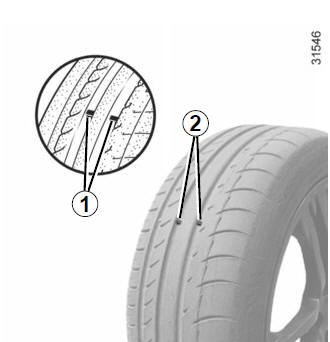Renault Koleos Owners Manual: Tyres
The tyres are the only contact between the vehicle and the road, so it is essential to keep them in good condition. You must make sure that your tyres conform to local road traffic regulations.
Maintaining the tyres The tyres must be in good condition and the tread form must have sufficient depth; tyres approved by our Technical Department have tread wear indicators 1 which are indicators moulded into the tread at several points. When the tread has worn down to the wear warning strips, these strips will become visible 2: it is then necessary to replace your tyres because the tread rubber is now only 1.6 mm deep at most, resulting in poor road holding on wet roads. An overloaded vehicle, long journeys by motorway, particularly in very hot weather, or continual driving on poorly surfaced minor roads will lead to more rapid tyre wear and affect safety.
Tyre pressures Adhere to the tyre pressures (including the emergency spare wheel). The tyre pressures should be checked at least once a month and additionally before any long journey (refer to the label affixed to the edge of the driver's door).
The pressures should be checked cold: ignore higher pressures which may be reached in hot weather or following a high speed journey. If the tyre pressures cannot be checked when the tyres are cold, increase the pressures from 0.2 to 0.3 bar (or 3 PSI). Never deflate a hot tyre. Special note Depending on the vehicle, there may be an adapter which needs to be positioned on the valve before air is added.
Vehicle fitted with a tyre pressure
monitoring system
In cases of under-inflation (puncture,
low pressure, etc.), warning light Fitting new tyres
Use in winter Chains For safety reasons, fitting snow chains to the rear axle is strictly forbidden. Chains cannot be fitted to tyres which are larger than those originally fitted to the vehicle. Snow or Winter tyres We would recommend that these be fitted to all four wheels to ensure that your vehicle retains maximum adhesion. Warning: These tyres sometimes have a specific direction of rotation and a maximum speed index which may be lower than the maximum speed of your vehicle.
Studded tyres This type of equipment may only be used for a limited period and as laid down by local legislation. It is necessary to observe the speed specified by current legislation. These tyres must, at a minimum, be fitted to the two front wheels.
|
See More:
Renault Koleos Owners Manual > Getting to know your vehicle: Additional methods of restraint
All of the warnings below are given so that the airbag is not obstructed in any way when it is inflated and also to prevent the risk of serious injuries caused by items which may be dislodged when it inflates. The airbag is designed to complement the action of the seat belt. Both the air bags and se ...
Renault Koleos Owners Manual
- Getting to know your vehicle
- Driving
- Your comfort
- Maintenance
- Practical advice
- Technical specifications


 lights up on the instrument panel.
lights up on the instrument panel.
